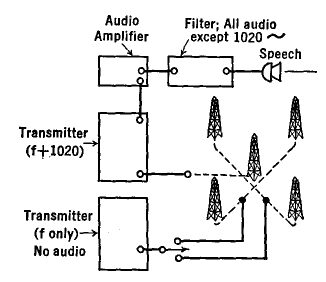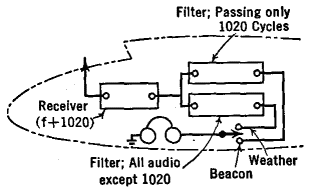| Basic Radio is a free introductory textbook on electronics based on tubes. See the editorial for more information.... |

|

Home  Transmission of Signals Transmission of Signals  Direction Finders Direction Finders  Simultaneous Weather and Beacon Transmission Simultaneous Weather and Beacon Transmission |
|||||






|
|||||
|
Simultaneous Weather and Beacon TransmissionAuthor: J.B. Hoag The government radio beacons, established for the guidance of aircraft, are also used in peacetime for the very important purpose of broadcasting weather reports. Formerly it was necessary to interrupt the beacon signals in order to transmit the weather reports. When the pilot was working an orientation problem, this interruption made it necessary for him to circle until the broadcast was complete. This waste of flying time, and of gasoline, made for unsafe conditions. In order to transmit both beacon and weather signals simultaneously, a fifth tower has been added to the previously described antenna array, as shown in Fig. 34 P.
The carrier frequency sent out from this new tower differs in frequency from that of the beacon by only 1,020 cycles per second. Combining with that from the beacon, it gives a 1,020-cycle " beat-note " in the receiver. This is a moderately high-pitched note. The central tower's carrier wave is modulated by the weather report, covering all audible frequencies except for a very narrow band in the neighborhood of 1,020. The removal of this note by means of a band elimination filter does not affect the intelligibility of the speech. The output of the aircraft receiver is passed through two separate filters, as in Fig. 34 Q, one of which allows only the 1,020-cycle note to pass and is used for the beacon signals.
When desired, the pilot may turn a switch and listen to the weather reports coming through the other filter, the one which passes all audio notes except 1,020 cycles.
|
|||||
Home  Transmission of Signals Transmission of Signals  Direction Finders Direction Finders  Simultaneous Weather and Beacon Transmission Simultaneous Weather and Beacon Transmission |
|||||
Last Update: 2009-11-01



